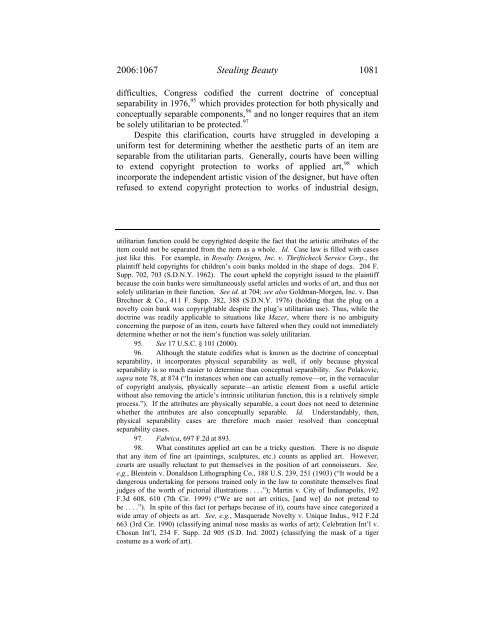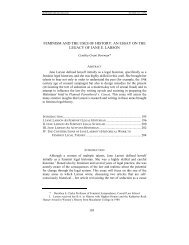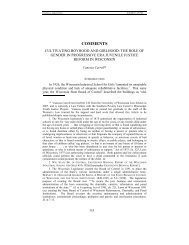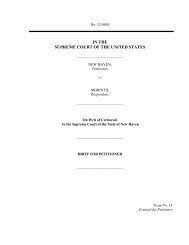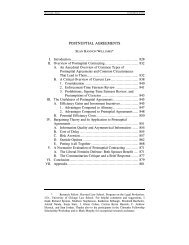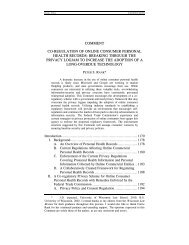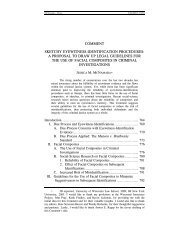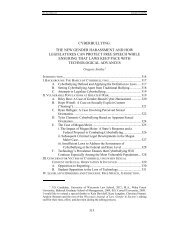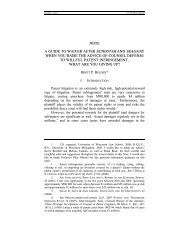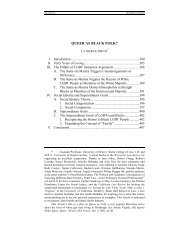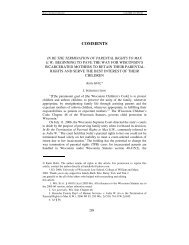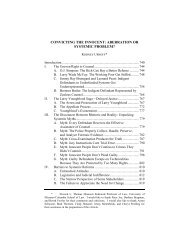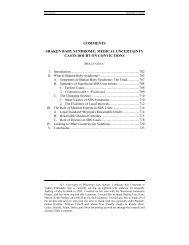Stealing Beauty: Pivot Point International v ... - UW Law School
Stealing Beauty: Pivot Point International v ... - UW Law School
Stealing Beauty: Pivot Point International v ... - UW Law School
Create successful ePaper yourself
Turn your PDF publications into a flip-book with our unique Google optimized e-Paper software.
2006:1067 <strong>Stealing</strong> <strong>Beauty</strong> 1081<br />
difficulties, Congress codified the current doctrine of conceptual<br />
separability in 1976, 95 which provides protection for both physically and<br />
conceptually separable components, 96 and no longer requires that an item<br />
be solely utilitarian to be protected. 97<br />
Despite this clarification, courts have struggled in developing a<br />
uniform test for determining whether the aesthetic parts of an item are<br />
separable from the utilitarian parts. Generally, courts have been willing<br />
to extend copyright protection to works of applied art, 98 which<br />
incorporate the independent artistic vision of the designer, but have often<br />
refused to extend copyright protection to works of industrial design,<br />
utilitarian function could be copyrighted despite the fact that the artistic attributes of the<br />
item could not be separated from the item as a whole. Id. Case law is filled with cases<br />
just like this. For example, in Royalty Designs, Inc. v. Thrifticheck Service Corp., the<br />
plaintiff held copyrights for children’s coin banks molded in the shape of dogs. 204 F.<br />
Supp. 702, 703 (S.D.N.Y. 1962). The court upheld the copyright issued to the plaintiff<br />
because the coin banks were simultaneously useful articles and works of art, and thus not<br />
solely utilitarian in their function. See id. at 704; see also Goldman-Morgen, Inc. v. Dan<br />
Brechner & Co., 411 F. Supp. 382, 388 (S.D.N.Y. 1976) (holding that the plug on a<br />
novelty coin bank was copyrightable despite the plug’s utilitarian use). Thus, while the<br />
doctrine was readily applicable to situations like Mazer, where there is no ambiguity<br />
concerning the purpose of an item, courts have faltered when they could not immediately<br />
determine whether or not the item’s function was solely utilitarian.<br />
95. See 17 U.S.C. § 101 (2000).<br />
96. Although the statute codifies what is known as the doctrine of conceptual<br />
separability, it incorporates physical separability as well, if only because physical<br />
separability is so much easier to determine than conceptual separability. See Polakovic,<br />
supra note 78, at 874 (“In instances when one can actually remove—or, in the vernacular<br />
of copyright analysis, physically separate—an artistic element from a useful article<br />
without also removing the article’s intrinsic utilitarian function, this is a relatively simple<br />
process.”). If the attributes are physically separable, a court does not need to determine<br />
whether the attributes are also conceptually separable. Id. Understandably, then,<br />
physical separability cases are therefore much easier resolved than conceptual<br />
separability cases.<br />
97. Fabrica, 697 F.2d at 893.<br />
98. What constitutes applied art can be a tricky question. There is no dispute<br />
that any item of fine art (paintings, sculptures, etc.) counts as applied art. However,<br />
courts are usually reluctant to put themselves in the position of art connoisseurs. See,<br />
e.g., Bleistein v. Donaldson Lithographing Co., 188 U.S. 239, 251 (1903) (“It would be a<br />
dangerous undertaking for persons trained only in the law to constitute themselves final<br />
judges of the worth of pictorial illustrations . . . .”); Martin v. City of Indianapolis, 192<br />
F.3d 608, 610 (7th Cir. 1999) (“We are not art critics, [and we] do not pretend to<br />
be . . . .”). In spite of this fact (or perhaps because of it), courts have since categorized a<br />
wide array of objects as art. See, e.g., Masquerade Novelty v. Unique Indus., 912 F.2d<br />
663 (3rd Cir. 1990) (classifying animal nose masks as works of art); Celebration Int’l v.<br />
Chosun Int’l, 234 F. Supp. 2d 905 (S.D. Ind. 2002) (classifying the mask of a tiger<br />
costume as a work of art).


